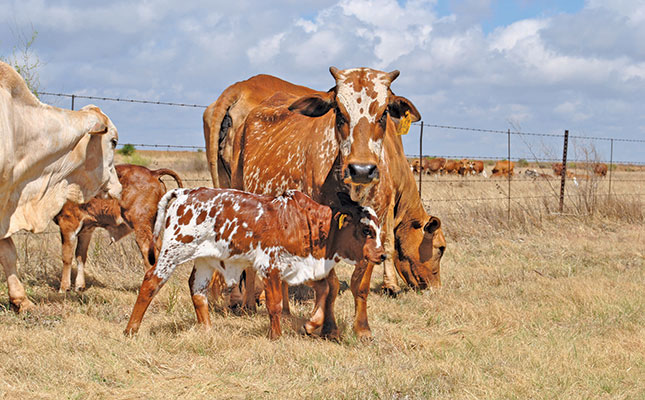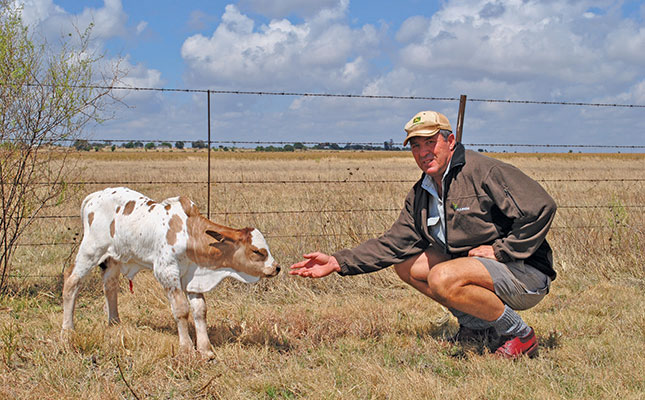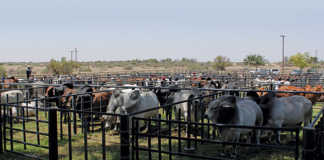
Photo: Pieter Dempsey
Johan Erasmus, who owns and runs the Jeras Boran stud on the farm Wolvengat near Derby in North West, has been farming for 37 years. A founding member of the Boran Cattle Breeders’ Society of South Africa (Boran SA), he helped write the society’s constitution and remains involved in the promotion of the Boran breed.
Last year, he was named the Farmer’s Weekly/SA Stud Book Elite Mentor Breeder of the Year.
The award recognises the remarkable and ongoing mentorship that Erasmus
has provided to emerging and commercial farmers, as well as fellow stud breeders. This includes the following:
- He mentors two groups of breeders in Bulawayo, Zimbabwe.
- Since 2013, he has helped a number of communal farmers in Namibia, especially in the Ovamboland, where the Boran breed has achieved great success.
- He is involved in a project on the farm Rayton in Mpumalanga, providing assistance and mentorship to a community livestock farming project. This involves a local church, which supports, among others, a local orphanage with food donations. In addition, he provides practical training in herd management and other skills for students from the universities of Mpumalanga and Pretoria.
- He is part of a joint venture providing training to emerging cattle farmers in North West that will enable the farmers to own and manage their own Boran herds within the next few years.
- He is involved in a project run by Boran SA in which registered Boran bulls are donated to selected farmers, giving them access to better genetics for improving their own herds.
- He follows up with these farmers and provides regular mentoring.
As a result of his involvement in this project, he was asked by the Potchefstroom Agricultural College to present a course on cattle farming and, specifically, on the Boran breed.

This course teaches aspiring cattle farmers about the characteristics of the Boran and the advantages of farming this breed.
Erasmus also assists breeders who cannot afford to buy stud bulls, hiring his bulls out to farmers to improve the genetics of their own herds.
A pioneer
Erasmus started farming cattle in 1986, but it was not until 2003, the year that he and a handful of other farmers founded Boran SA, that he established his own Boran stud. He was one of the first breeders in South Africa to import Boran genetics from Kenya, where the breed originates.
READ Owning the value chain – Boran stud’s success story
In addition, Erasmus produces maize, soya bean and sunflower in rotation on 1 600ha of the 3 500ha farm, and runs a commercial Boran herd on a 7 000ha farm near Mbombela in Mpumalanga.
Breeding and profitability
The stud herd currently comprises 14 stud bulls, 62 bulls that will be offered for sale, 500 breeding cows, 124 replacement heifers and 140 weaners.
Ensuring sustainable profitability is central to continued success, says Erasmus, and he follows a strict business plan for all the divisions in his farming business.
“Profit is determined by the amount of beef produced per hectare, not by the weight of the weaners,” he stresses.
The hardiness and productivity of the Boran were amongst the traits that made him choose the breed.
“They’re adapted to African conditions and perform well on the veld.”
He also insists that animals be adapted to the area in which they are kept. Cows that are well adapted will remain in good condition, produce calves and be resistant to parasites, he says.
Cows should always have a calf at foot or be in-calf.
READ Boran bull sold for R1,7m sets new South African record
“If a cow fails to produce a calf in a breeding season, she is culled. I’ll excuse first-time calvers once, but after that they are removed.”
Erasmus aims to breed strong, but feminine cows, and masculine bulls.
“Hair quality is of cardinal importance. The coat should be shiny and smooth,” he says, adding that hair quality is linked to several other traits, such as fertility and adaptability.
As part of his selection process, he uses phenotypical criteria, such as the depth of the chest. However, selecting a bull based solely on phenotype will not necessarily predict the quality of its progeny.
The best way to thus predict the progeny of a bull is by inspecting his dam and maternal grand dam, his sisters (especially maternal), and his own progeny, if possible, he explains.
Erasmus strives for effective and profitable animals that can perform on the veld, with high efficiency in terms of the calf-to-cow ratio and low input costs. Performance testing is crucial, but certain aspects are more important than others, he says.
“For female animals, I look at the age of first calving, the inter-calving period, and the cow-to-calf weight ratio, which is determined by measuring the weight ratio between the cow and the calf at weaning,” he explains.
Weighing and testing
The 12-month and 18-month weights are not important to him, as these do not add value in terms of his selection process. For this reason, he does not measure birth weights, but weighs the calves at weaning to determine the cow-to-calf ratio.
He also plans to add extensive Phase D testing for his bulls, which undergo growth tests under veld conditions. This, he says, will add another element to his selection process.
grazing and supplementation
Erasmus’s supplemental feed and lick programmes are made up of mainly chicken manure mixed with a phosphorus supplement and other minerals.
Creep feed, which comprises a mix of high-protein concentrate, molasses and ground cob meal, is given to calves.
Grazing on Wolvengat is predominately sourveld, and the farm receives an average annual rainfall of approximately 620mm.
READ Make more money with your livestock
Erasmus is able to maintain a stocking rate of 6ha/1 LSU, which is in line with the farm’s carrying capacity. There are no planted pastures, but cows with calves are grazed on the grain-crop residue.
The animals graze in rotation on 36 camps, which range in size from 30ha to 100ha. To increase the stocking rate, however, Erasmus plans to reduce the size of the larger camps to between 30ha and 40ha.
He has also begun implementing ultra-high stock density grazing, which will double his carrying capacity to 3ha/1 LSU.
Boran cattle do not generally receive treatment for internal or external parasites, as the sebum secretion on the animals’ skin deters parasites from adhering.
Erasmus does, however, vaccinate against certain diseases such as botulism, and each female animal receives two doses of RB51 for Brucella to protect them against infection and abortion.
According to Erasmus, one of the worst mistakes he ever made was to place too much emphasis on phenotype when selecting bulls.
“I learnt that it’s very important to conduct research when selecting a bull and ask for
help from other, more experienced breeders. The wrong bull can set your stud back five years,” he says.
Erasmus is currently in a building phase with his herd, as he intends scaling down his grain business and focusing solely on cattle. His goal is to reach this point in about eight years.
His advice for prospective breeders is to focus on breeding cattle that are commercially viable and of value to commercial breeders.
Email Johan Erasmus at [email protected].













